 Add Void Space Layout ( Modeling > press F2 > " Void Space Layout ")
Add Void Space Layout ( Modeling > press F2 > " Void Space Layout ")
- Locate layout points in the same plane to add a void space layout member. The layout will create voids in materials through which it passes.
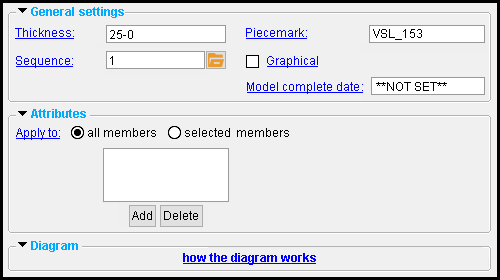 |
The layout points will be shown and can be modified in the diagram . Locate the points in a consistent counter-clockwise or clockwise manner. |
- See the step-by-step instructions .
Also see :
- Modeling (where custom members can be added)
- Custom members (topic)
- Delete key (or choose Edit > Delete to delete a custom member)
- Model > Member > Copy (can be used to copy a void space layout member)
- Model > Member > Move/Stretch (to move a void space layout member)
- Automatically process after modeling operation ( User and Site Options > Modeling > affects " OK ")
- Voids ( Display Options )
page 1 | contents | F2 > other > void space layout | locate workpoints | top
Step-by-step instructions :
To add a void space layout, you should be in Modeling in a non-isometric view:
1 . In Modeling , go to a flat (non-isometric) view in which -- in step 3 -- you want to lay out points. Tools that can get you to a desirable view include View > Section View and View > Relative Depth . Using Navigate > Snap to Surface together with View > Relative Depth can put your layout a specific distance from a material.
2 . Press F2 or choose Model > Member > Prompt for Member Type , then double-click " Void Space Layout " on the Member Type Selection window.
3 . Locate layout points in a consistent counter-clockwise or clockwise direction. The direction that you choose sets the direction of the " Thickness " dimension. This window -- the Void Space Layout Edit window -- will open when you have drawn a closed figure (or when you have middle-clicked ( OK )).


bindings , step 2 4 . On this window, you will probably want to, at the very least, enter a " Thickness ." When you press " OK ," the void space layout member is added to the model. Right-click ( Cancel ) if you are done adding void space layout members.


bindings , step 3
page 1 | contents | F2 > other > void space layout | locate workpoints | top
------  General settings ------
General settings ------
Thickness: A positive distance or negative distance (in the primary dimension " Units " or other units ). This sets the depth into the screen or out of the screen that the void will be extruded from the plane in which the layout points were added.
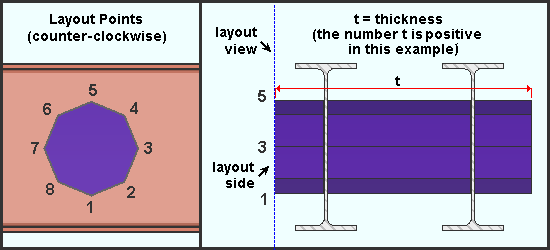
|
| This example shows a counter-clockwise layout in a plane that was several inches in from of the near side face of a beam. Since the " Thickness " that the user entered was a positive distance ( t ), the t dimension of the void is projected into the screen to the far side face of the beam and beyond yet another beam |
A positive distance extends the volume of the void space into your computer screen the distance that is entered if the layout points were added counter-clockwise. If the layout points were added clockwise, a positive distance extends the void space volume in the opposite direction (toward you, the viewer).
A negative distance extends the volume of the void space into your computer screen the distance that is entered if the layout points were added clockwise. If the layout points were added counter-clockwise, a positive distance extends the void space volume in the opposite direction (toward you, the viewer).
Sequence: Any sequence name from the Sequence Names setup list can be entered. Either type the sequence, or you can press the "file cabinet" browse button ( ![]() ) and double-click any sequence name that is on the list.
) and double-click any sequence name that is on the list.
Tip: If you want to add a new sequence so that it can be selected here, you should first increase the number of " Maximum sequences " that are available.
Piecemark: The member piecemark of the void space layout.
Typing in characters makes the piecemark a user piecemark .
To clear a user piecemark, or if you are adding a new void space layout member, leave this field blank. Piecemarking will assign a system piecemark when you press " OK ."
Graphical: ![]() or
or ![]() . This member is automatically marked as "
. This member is automatically marked as " ![]() Graphical" if you, for example, perform a Cut On Plane operation on the void member's material.
Graphical" if you, for example, perform a Cut On Plane operation on the void member's material.
If this box is checked (
), changes you make on this window -- for example, to the " Thickness " of the void space -- will not be applied in the model since the member is prevented from undergoing Create Solids .
If the box is not checked (
), any graphical changes made to this void space will be lost the next time the member undergoes Create Solids . Also, any entries made on this window will be applied to the member at that time. If User and Site Options > Modeling > " Automatically process after modeling operation " is set to ' Process and create solids ', then this member will automatically be regenerated ( Create Solids will take place) after your press " OK ."
Note: A void space is dummy material with special properties. The material does not have an edit window, but you can perform certain material operations on it. For example, you can perform cut operations on it. Doing so makes the void space member graphical.
Model complete date: **NOT SET** or a month day year (see entering dates ).
' **NOT SET** ' removes the status designation of "model complete" from a member, thus allowing that member to be physically altered. To enter **NOT SET** , type in 0 then press Tab .
If a ' month day year ' is entered, Process and Create Solids is prevented from making certain changes to the member. For example, if you change the " Thickness " of the void space, that thickness will not be changed in the model so long as the date remains set. To enter today's date, double-click.
Setup: Auto model complete type .
page 1 | contents | F2 > other > void space layout | locate workpoints | top
------  Attributes ------
Attributes ------
Apply to: ![]() all members or
all members or ![]() selected members .
selected members .
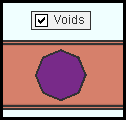
|
" Voids " is turned on (checked) in Display Options . This void would be displayed as shown regardless of whether the choice made here was ' all members ' or ' selected members '. |
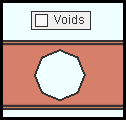
|
" Voids " is turned off (not checked) in Display Options . For material to be removed by a void as shown here, " Apply to " must be set to ' all members ' or to ' selected members ' with the member that is shown here also shown in the list . |
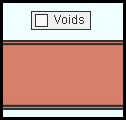
|
" Voids " is turned off (not checked) in Display Options . " Apply to " is set to ' selected materials ', but the beam shown here is not included in the list . As a result, the beam is solid, with no material removed by the void. |
'
all members ' results in the materials of all members that clash with this void being voided where they clash.
'
selected materials ' lets you select which members you want to be affected by the void. Only those members that you select by pressing " Add " to place them in the list will be voided at the locations where they are impinged upon by the void. For steel materials, the " Weight of item " and " Surface area " reported on the member material's General Information window will be reduced only if those members are listed.
Example of a "selected members" list:

When " Apply to " is set to ' selected members ', only members assigned B_1 [num1] or B_2 [num2] or B_3 [num3] will have material removed when the void passes through them. To add members to the list, press the " Add " button. The program lets you select (by piecemark and [ member number ]) the members that you want to include.
To remove a member from the list, select it then press the " Delete " button.
page 1 | contents | F2 > other > void space layout | locate workpoints | top
------  Diagram ------
Diagram ------
 |
| Since ' X-Y ' is the " View " shown here, the " Diagram " shows the layout points in the plane in which they were added. |
Axes : Although the diagram's origin point is expressed in the member coordinates of the member that the void space belongs to, the diagram's coordinate system may or may not coincide with the member coordinate system. In other words, the axes shown in the diagram may or may not be parallel with the member axes.
Radius: A distance (in the primary dimension " Units " or other units ) that defines the degree to which the corner is rounded.
The " Radius " is the radius of a circle. Two lines that are tangent to that circle meet at the located point. The arc of the rounded corner ends at the points of tangency of these two lines. 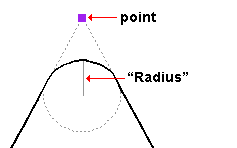
A " Radius " of ' 0 ' designates a sharp corner with no corner rounding.
Increasing the " Radius " moves the edge of the rounded corner back from the corner point. This is because the " Radius " defines a circle that is tangent to both lines to the corner point. The arc of the rounded corner begins and ends at the tangent points.
You can set a different " Radius " for each corner. Clicking on the upper-right corner of the table (" Radius > ") lets you set the radius for each point to be the same value.
' X-Y ' shows the layout points in a flat plane that includes those points. This is typically the best view to see all of a void's layout points and to most easily correlate those points to the coordinates shown in the table.
' X-Z ' shows a elevation view of the layout points in a flat, X-Z plane that is at right angles to (orthogonal to) the Y axis. In such a view, the layout points for a void whose " Z-axis " values are all the same will appear as a single line.
' Y-Z ' shows a elevation view of the layout points in a flat, Y-Z plane that is orthogonal to the X global axis. In such a view, the layout points for a void whose " Z-axis " values are all the same will appear as a single line.
Dimension by: Length and angle or Previous point or Origin point . This applies when you hover a point in the diagram with your mouse pointer ( ![]() ), regardless of whether or not you are adding points.
), regardless of whether or not you are adding points.
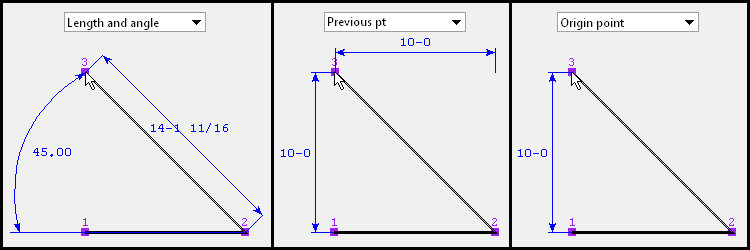
' Length and angle ' shows one or two dimensions and an angle. The dimension(s) are to the point you are hovering. One dimension may be to the previous point, and another dimension may be to the next point. The angle to the point you are hovering may be the included angle between the hovered point and the previous two points. Or it may be the angle between the hovered point and a horizontal or vertical bisector to the previous point.
VIDEO 
" Dimension by " is set to ' Length and angle ' and the distance and angle between points is defined for the first two points. Additional points are defined by clicking instead of typing. ' Previous point ' shows horizontal and/or vertical dimensions between the point you are hovering and the previous point in the diagram. Dimensions of zero will not be shown.
' Origin point ' shows horizontal and/or vertical dimensions from the origin point (point 1) to the point you are hovering. Dimensions of zero will not be shown.
Adding points: You can click a line in the diagram to add a point. The new point snaps to your mouse pointer until you left-click to locate that point or right-click to cancel. Dimensions are shown as you move your mouse pointer to reposition the snapped-to point. An alternative to clicking in the diagram to add points is to enter the points to the table.
page 1 | contents | F2 > other > void space layout | locate workpoints | top







